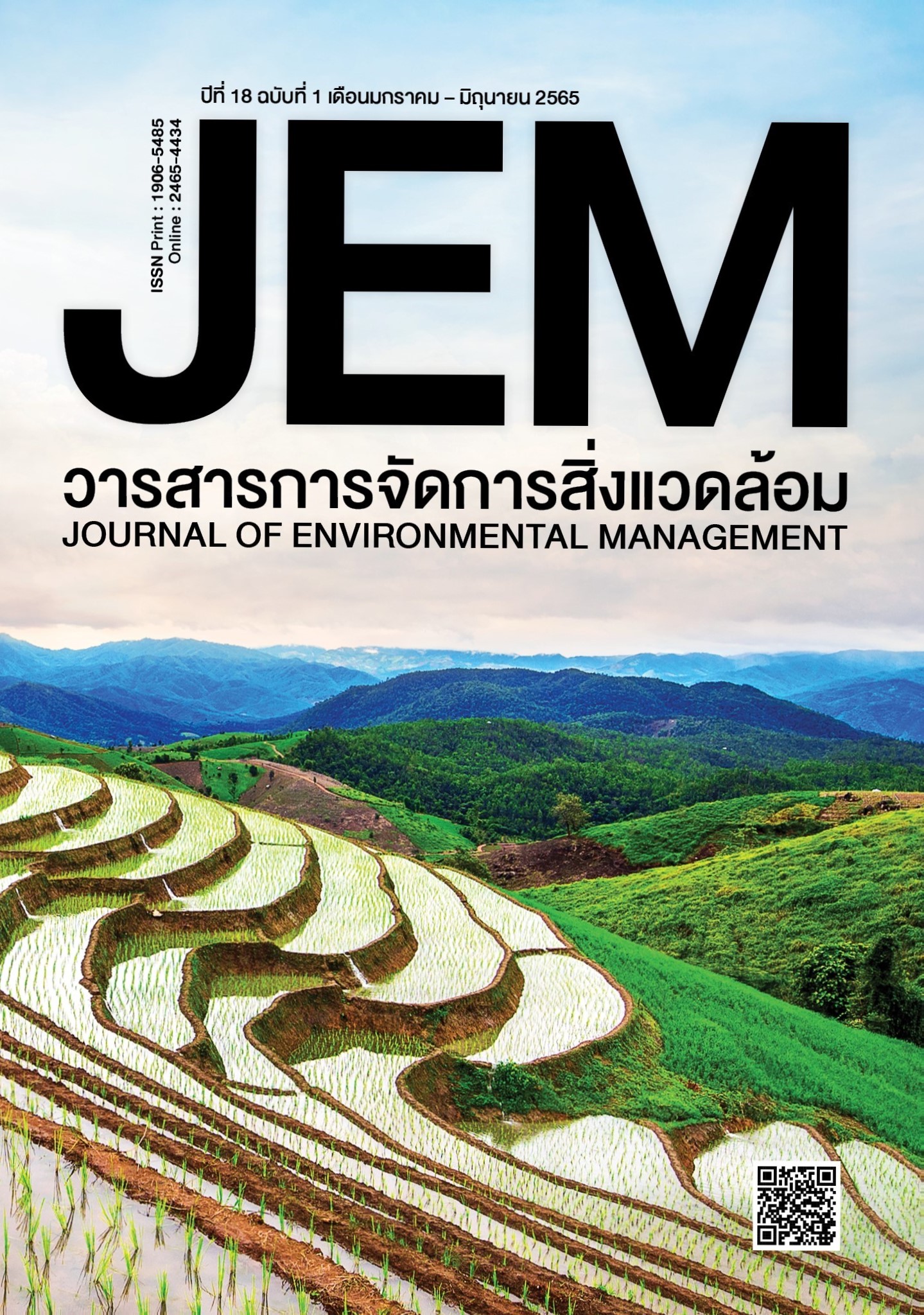แบบจำลองถดถอยถ่วงน้ำหนักเชิงพื้นที่และเวลา สำหรับการประมาณค่าฝุ่นละออง ขนาดไม่เกิน 2.5 ไมครอน (PM2.5) พื้นที่ประเทศไทย
DOI:
https://doi.org/10.14456/jem.2022.3คำสำคัญ:
ฝุ่นละอองขนาดไม่เกิน 2.5 ไมครอน, ความลึกเชิงแสงของฝุ่นละออง, แบบจำลองถดถอยถ่วงน้ำหนักเชิงพื้นที่และเวลาบทคัดย่อ
งานวิจัยนี้มีวัตถุประสงค์เพื่อพัฒนาแบบจำลองถดถอยถ่วงน้ำหนักเชิงพื้นที่และเวลา (GTWR) สำหรับการประมาณค่าฝุ่นละอองขนาดไม่เกิน 2.5 ไมครอน (PM2.5) พื้นที่ประเทศไทย โดยรวบรวมข้อมูลการศึกษาตั้งแต่เดือนพฤษภาคม 2557 ถึงเมษายน 2562 ผลการศึกษาพบว่าความลึกเชิงแสงของฝุ่นละออง (AOD) อุณหภูมิ ความชื้นสัมพัทธ์ ความเร็วลม และความสูงชั้นผสม ที่ใช้เป็นตัวแปรอิสระในการพัฒนาแบบจำลอง GTWR ประมาณค่าความเข้มข้นของ PM2.5 ของ PM2.5 ที่ค่า R2 เท่ากับ 0.71 โดยมีค่า RMSE และค่า MAE เท่ากับ 14.55 และ 10.04 ไมโครกรัมต่อลูกบาศก์เมตร ตามลำดับ ซึ่งตัวแปรที่ส่งผลต่อการเปลี่ยนเปลี่ยนแปลงของ PM2.5 จากมากที่สุดไปยังน้อยที่สุด ได้แก่ AOD ความชื้นสัมพัทธ์ ความสูงชั้นผสม ความเร็วลม และอุณหภูมิ และจากการทดสอบแบบจำลอง GTWR สำหรับการประมาณค่า PM2.5 ด้วยข้อมูลการตรวจวัดจริง พบว่าแบบจำลอง GTWR อธิบายความแปรปรวนของ PM2.5 ในฤดูแล้ง (เดือนเมษายน 2562) ได้ดีกว่าฤดูฝน (เดือนตุลาคม 2561) โดยในฤดูแล้งแบบจำลอง GTWR สามารถประมาณค่าความเข้มข้นของ PM2.5 ที่ค่า R2 เท่ากับ 0.76 โดยมีค่า RMSE และค่า MAE เท่ากับ 18.32 และ 14.20 ไมโครกรัมต่อลูกบาศก์เมตร ตามลำดับ
เอกสารอ้างอิง
Bai, Y., Wu, L., Qin, K., Zhang, Y., Shen, Y., Zhou, Y. (2016). A geographically and temporally weighted regression model for ground-level PM2.5 estimation from satellite-derived 500 m resolution AOD. Remote Sensing, 8(3), 262.
Chavanaves, S., Fantke, P., Limpaseni, S., Attavanich, W., Panyametheekul, S., Gheewala, S. H., Prapaspongsa, T. (2021). Health impacts and costs of fine particulate matter formation from road transport in Bangkok Metropolitan Region. Atmospheric Pollution Research, 12(10), 101191.
Fotheringham, A. S., Brunsdon, C., Charlton, M. (2002). Geographically Weighted Regression: The Analysis of Spatially Varying Relationships. New York.
Guo, Y., Tang, Q., Gong, D. Y., Zhang, Z. (2017). Estimating ground-level PM2.5 concentrations in Beijing using a satellite-based geographically and temporally weighted regression model. Remote Sensing of Environment, 198, 140-149.
Gupta, P., Remer, L. A., Levy, R. C., Mattoo, S. (2018). Validation of MODIS 3 km land aerosol optical depth from NASA’s EOS Terra and Aqua missions. Atmospheric Measurement Techniques, 11, 3145-3159.
He, Q., Haung, B. (2018). Satellite-based high-resolution PM2.5 estimation over the Beijing-Tianjin-Hebei region of China using an improved geographically and temporally weighted regression model. Environmental Pollution, 236, 1027-1037.
Huang, B., Wu, B., Barry, M. (2010). Geographically and temporally weighted regression for modeling spatio-temporal variation in house prices. International Journal of Geographical Information Science, 24(3), 383-401.
Janjai, S. (2014). Solar Radiation [In thai]. Nakhon Pathom: Phetkasem Printing Group.
Kanabkaew, T. (2013). Prediction of Hourly Particulate Matter Concentrations in Chiangmai, Thailand Using MODIS Aerosol Optical Depth and Ground-Based Meteorological Data. EnvironmentAsia, 6(2), 65-70.
Kwanma, P., Pukngam, S., Arunpraparut, W. (2019). Meteorological factors affecting concentration of PM10 at Na Phra Lan Sub-district, Chaloem Phra Kiat District, Saraburi Province [In Thai]. PSRU journal of Science and Technology, 4(2), 85-94.
Li, T., Hu, R., Chen, Z., Li, Q., Huang, S., Zhu, Z., Zhou, L. F. (2018). Fine particulate matter (PM 2.5): The culprit for chronic lung diseases in China. Chronic Diseases and Translational Medicine, 4(3), 176-186.
Ma, Z., Hu, X., Huang, L., Bi, J., Liu, Y. (2014). Estimating ground-level PM2.5 in China using satellite remote sensing. Environmental Science & Technology, 48, 7436-7444.
Park, S., M. Shin, J. Im, C. K. Song, M. Choi, J. Kim, S. Lee, R. Park, J. Kim, D. W. Lee, S. K. Kim. (2019). Estimation of ground-level particulate matter concentrations through the synergistic use of satellite observations and process-based models over South Korea. Atmospheric Chemistry and Physics, 19, 1097-1113.
Pollution Control Department. (2019). Booklet on Thailand State of Pollution 2018. Bangkok: S.Mongkon Press Limited Partnership.
Pollution Control Department. (2022). National Ambient Air Quality Standards [In Thai]. Retrieved January 1, 2022, from http://air4thai.pcd.go.th/webV3/#/Download.
Remer, L. A., Mattoo, S., Levy, R. C., Munchak, L. A. (2013). MODIS 3 km aerosol product: algorithm and global perspective. Atmospheric Measurement Techniques, 6(7), 1829-1844.
Thai Meteorological Department. (2021). Thailand Weather [In Thai]. Retrieved October 10, 2021, from https://www.tmd.go.th/info/info.php?FileID=22.
Wei, J., Li, Z., Peng, Y., Sun, L. (2019). MODIS collection 6.1 aerosol optical depth products over land and ocean: validation and comparison. Atmospheric Environment, 201, 428-440.
You, W., Zang, Z., Zhang, L., Li, Y., Pan, X., Wang, W. (2016). National-scale estimates of ground-level PM2.5 concentration in china using geographically weighted regression based on 3 km resolution MODIS AOD. Remote Sensing, 8(3), 184.



